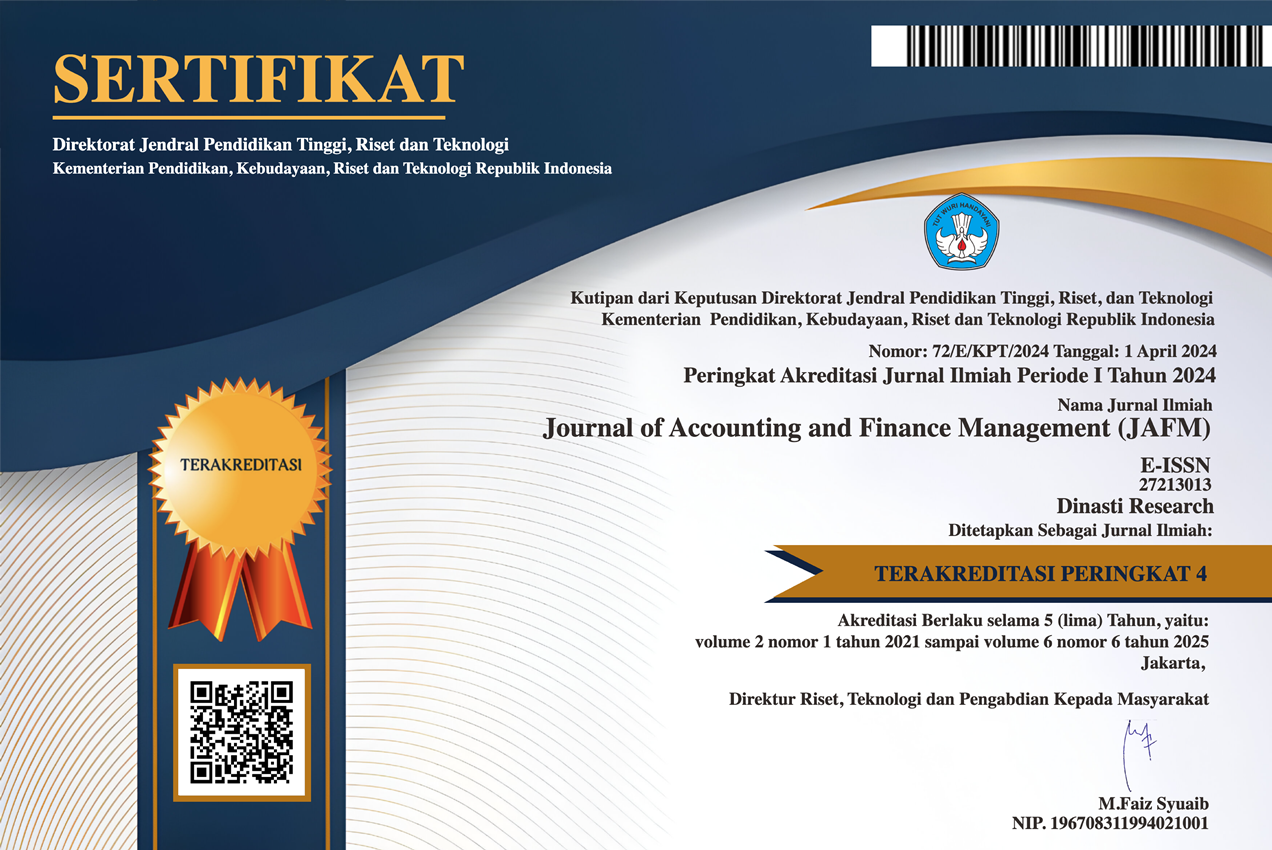Investor Behavior in Cryptocurrency Market in Indonesia: The Role of Trust, Regulation, Digital Access and Risk Perception Through Psycological Empowerment
DOI:
https://doi.org/10.38035/jafm.v6i4.2379Keywords:
Cryptocurrency Investment, Investor Behavior, Psychological EmpowermentAbstract
This study examines the determinants of investor behavior in Indonesia’s cryptocurrency market, focusing on trust, regulation, digital access, and risk perception, with psychological empowerment as a mediating variable. Motivated by the rapid growth of crypto adoption in Indonesia alongside issues of volatility, regulatory uncertainty, and varying levels of digital literacy, the research aims to identify how these factors influence investment decisions. A quantitative explanatory design was applied, using a structured online questionnaire distributed to 150 active Indonesian cryptocurrency investors selected through stratified random and snowball sampling. Data were analyzed using Partial Least Squares-Structural Equation Modeling (PLS-SEM) to assess measurement validity, structural relationships, and mediation effects. The results show that trust, regulation, and digital access positively and significantly influence investor behavior, while risk perception has a positive but significant impact. Psychological empowerment was found to partially mediate the relationship between all independent variables and investor behavior, indicating that confidence, autonomy, and self-efficacy enhance the translation of external conditions into active investment. These findings highlight the importance of strengthening regulatory clarity, enhancing platform security, expanding digital access, and fostering investor empowerment to promote responsible and sustainable cryptocurrency participation in Indonesia.
References
Adrianto, F. (2021). The prospect of Indonesian government retail Sukuk: From the perspective of Sharia financial knowledge, education, and behavior. DLSU Business and Economics Review, 30(2), 50-60.
Ajzen, I. (1991). The theory of planned behavior. Organizational behavior and human decision processes, 50(2), 179-211.
Ajzen, I. (2011). The theory of planned behaviour: Reactions and reflections. Psychology & health, 26(9), 1113-1127.
Alalwan, A. A., Dwivedi, Y. K., & Rana, N. P. (2017). Factors influencing adoption of mobile banking by Jordanian bank customers: Extending UTAUT2 with trust. International journal of information management, 37(3), 99-110.
Alekseenko, A. P. (2023). Model framework for consumer protection and crypto-exchanges regulation. Journal of Risk and Financial Management, 16(7), 305.
Alzyoud, S., Alshurafat, H., & Khatatbeh, I. N. (2025). Understanding cryptocurrency investment behaviour in Jordan: an examination of motivational drivers through the lens of the UTAUT2 model. Studies in Economics and Finance, 42(1), 154-172.
Ariwangsa, I. O., Putra, K. W. S., & Laksmi, K. W. (2025). Empowering Investment Decisions Through Financial Literacy and Government Regulations on MSMES, 15(01), 47-61.
Asosiasi Penyelenggara Jasa Internet Indonesia. (2022). Profil Internet Indonesia 2022. https://online.fliphtml5.com/rmpye/ztxb/
Aysan, A. F., & Kayani, F. N. (2022). China's transition to a digital currency does it threaten dollarization?. Asia and the Global Economy, 2(1), 100023.
Aysan, A. F., Khan, A. I., Topuz, H., & Tunalı, A. S. (2021). Survival of the fittest: A natural experiment frım crypto exchanges.
Bland, E., Changchit, C., Cutshall, R., & Pham, L. (2024). Behavioral and Psychological Determinants of Cryptocurrency Investment: Expanding UTAUT with Perceived Enjoyment and Risk Factors. Journal of Risk and Financial Management, 17(10), 447.
Bodie Z, A Kane, AJ Marcus, & R Jain. Investment. Mcgraw-Hill Education.
Bougie, R., & Sekaran, U. (2019). Research methods for business: A skill building approach. john wiley & sons.
Bouri, E., Molnár, P., Azzi, G., Roubaud, D., & Hagfors, L. I. (2017). On the hedge and safe haven properties of Bitcoin: Is it really more than a diversifier?. Finance Research Letters, 20, 192-198.. https://doi.org/10.1016/j.frl.2016.09.025
Chauhan, R., & Patel, N. (2024). Unraveling investor behavior: Exploring the influence of behavioral finance on investment decision-making. Journal of Economics, Assets, and Evaluation, 1(4), 1-13.
Choi, Y., Han, S., & Lee, C. (2024). Exploring drivers of fintech adoption among elderly consumers. Technology in Society, 78, 102669. https://doi.org/10.1016/j.techsoc.2024.102669
CoinMarketCap. (2024). Cryptocurrency prices, charts and market capitalizations. https://coinmarketcap.com
CompaniesMarketCap. (2025). Assets by market cap. https://companiesmarketcap.com/assets-by-market-cap/
Corbet, S., Lucey, B., Urquhart, A., & Yarovaya, L. (2019). Cryptocurrencies as a financial asset: A systematic analysis. International Review of Financial Analysis, 62, 182-199.
Fang, F., Ventre, C., Basios, M., Kanthan, L., Martinez-Rego, D., Wu, F., & Li, L. (2022). Cryptocurrency trading: a comprehensive survey. Financial Innovation, 8(1), 13.
Farrell, L., Fry, T. R., & Risse, L. (2016). The significance of financial self-efficacy in explaining women’s personal finance behaviour. Journal of economic psychology, 54, 85-99.
Fourqoniah, F., Bharata, W., & Mahriani, M. W. (2024). The role of psychological aspects to measure Indonesian cryptocurrency investor behavior. Jurnal Ekonomi dan Bisnis, 27(2), 81-102.
Gandal, N., Hamrick, J. T., Moore, T., & Oberman, T. (2018). Price manipulation in the Bitcoin ecosystem. Journal of Monetary Economics, 95, 86-96.
Gefen D, E. Karahanna, & D. W. Straub. (2003). Trust and tam in online shopping: An integrated model1. MIS Quarterly, 27(1), 51-90.
Gefen, D., Karahanna, E., & Straub, D. W. (2003). Trust and TAM in online shopping: An integrated model. MIS Quarterly, 27(1), 51–90. https://doi.org/10.2307/30036519
Hair, J., & Alamer, A. (2022). Partial Least Squares Structural Equation Modeling (PLS-SEM) in second language and education research: Guidelines using an applied example. Research Methods in Applied Linguistics, 1(3), 100027.
Hasan, A., Alam, S., Habib, S., & Khan, A. M. (2024). Analysis of factors affecting investors’ decision towards cryptocurrency investments in Saudia Arabia: A moderating role of fear of missing out (FOMO) on decision-making. Journal of Infrastructure, Policy and Development, 8(9), 6419.
Hassan, S., Mai, N. H., Amin, M. B., Hassan, M., & Oláh, J. (2025). Decentralized Fintech Platforms Adoption Intention in Cyber Risk Environment among0 GenZ: A Dual-Method Approach Using PLS-SEM and Necessary Condition Analysis. Computers in Human Behavior Reports, 100687.
Heryana, A. (2020). Hipotesis penelitian. ResearchGate.
Jalan, A., Matkovskyy, R., Urquhart, A., & Yarovaya, L. (2023). The role of interpersonal trust in cryptocurrency adoption. Journal of International Financial Markets, Institutions and Money, 83, 101715.
Kementerian Perdagangan Republik Indonesia. (2024, October 28). Bappebti: Jumlah pelanggan aset kripto di Indonesia tembus 21,27 juta. https://www.kemendag.go.id/berita/pojok-media/bappebti-jumlah-pelanggan-aset-kripto-di-indonesia-tembus-2127-juta
Khusnul, K., & Prihatin, J. (2020, June). An Analysis of the utilization of Gamal Plant (Gliricidia sepium) as a shade for coffee plants. In Journal of Physics: Conference Series (Vol. 1563, No. 1, p. 012014). IOP Publishing.
Lusardi, A., & Mitchell, O. S. (2014). The economic importance of financial literacy: Theory and evidence. Journal of Economic Literature, 52(1), 5–44. https://doi.org/10.1257/jel.52.1.5
Madden, T. J., Ellen, P. S., & Ajzen, I. (1992). A comparison of the theory of planned behavior and the theory of reasoned action. Personality and social psychology Bulletin, 18(1), 3-9.
Martin, B. A., Chrysochou, P., Strong, C., Wang, D., & Yao, J. (2022). Dark personalities and Bitcoin®: The influence of the Dark Tetrad on cryptocurrency attitude and buying intention. Personality and Individual Differences, 188, 111453.
Murugappan, M., Nair, R., & Krishnan, S. (2023). Global market perceptions of cryptocurrency and the use of cryptocurrency by consumers: A pilot study. Journal of Theoretical and Applied Electronic Commerce Research, 18(4), 1955-1970.
Nakamoto, S. (2009). Bitcoin: A peer-to-peer electronic cash system Bitcoin: A Peer-to-Peer Electronic Cash System. Bitcoin. org. Disponible en https://bitcoin. org/en/bitcoin-paper.
Pham, Q. T., Phan, H. H., Cristofaro, M., Misra, S., & Giardino, P. L. (2021). Examining the intention to invest in cryptocurrencies: An extended application of the theory of planned behavior on Italian independent investors. International Journal of Applied Behavioral Economics (IJABE), 10(3), 59-79.
Pilatin, A., & Dilek, Ö. (2024). Investor intention, investor behavior and crypto assets in the framework of decomposed theory of planned behavior. Current Psychology, 43(2), 1309-1324.
Rehman, M. H. ur, Salah, K., Damiani, E., & Svetinovic, D. (2019). Trust in blockchain cryptocurrency ecosystem. IEEE Transactions on Engineering Management, 67(4), 1196-1212
Rezeki, R. N. S., & Ariefianto, M. D. (2023). Examining the role of attitude in mediating the influence of social media influencers, risk, fear of missing out, and herd behavior on interest to invest in stocks. Journal of System and Management Sciences, 13(3), 219–232. https://doi.org/10.33168/JSMS.2023.0315
Satomero A.M. & Babbel D.F. Financial market, instruments & institutions (second edition). Mcgraw-Hill/Irwin.
Sourirajan, S., & Perumandla, S. (2022). Do emotions, desires and habits influence mutual fund investing? A study using the model of goal-directed behavior. International Journal of Bank Marketing, 40(7), 1452-1476.
Srivastava, S. K., Deepika Chandra, V., Jangirala, S., & Yadav, J. K. (2024). The Genesis of the crypto-economy: Application of the institutional theory. Vikalpa, 49(3), 244-256.
Sugiono, S. (2004). Konsep, identifikasi, alat analisis dan masalah penggunaan variabel moderator. Jurnal Studi Manajemen Organisasi, 1(2), 61-70.
Thaler, R. H. (1999). The end of behavioral finance. Financial Analysts Journal, 55(6), 12-17.
Thangavelu Poonkulali. (2023). How Inflation Impacts Your Savings . Https://Www.Investopedia.Com/Articles/Investing/090715/How-Inflation- Affects-Your-Cash-Savings.Asp.
Venkatesh, V., Morris, M. G., Davis, G. B., & Davis, F. D. (2003). User acceptance of information technology: Toward a unified view. MIS quarterly, 425-478.
Wang, Y. S., Duong, N. T., Ying, C. H., & Chang, Y. C. (2024). What Drives People’s Cryptocurrency Investment Behavior. Journal of Computer Information Systems, 1-18.
Zetzsche, D. A., Arner, D. W., & Buckley, R. P. (2020). Decentralized finance. Journal of Financial Regulation, 6(2), 172-203.
Zetzsche, D. A., Buckley, R. P., Barberis, J. N., & Arner, D. W. (2017). Regulating a revolution: from regulatory sandboxes to smart regulation. Fordham J. Corp. & Fin. L., 23, 31.
Downloads
Published
How to Cite
Issue
Section
License
Copyright (c) 2025 Angga Putra Jayani, Fajri Adrianto, Masyhuri Hamidi

This work is licensed under a Creative Commons Attribution 4.0 International License.
Authors who publish their manuscripts in this journal agree to the following conditions:
- The copyright on each article belongs to the author(s).
- The author acknowledges that the Journal of Accounting and Finance Management (JAFM) has the right to be the first to publish with a Creative Commons Attribution 4.0 International license (Attribution 4.0 International (CC BY 4.0).
- Authors can submit articles separately, arrange for the non-exclusive distribution of manuscripts that have been published in this journal into other versions (e.g., sent to the author's institutional repository, publication into books, etc.), by acknowledging that the manuscript has been published for the first time in the Journal of Accounting and Finance Management (JAFM).



























